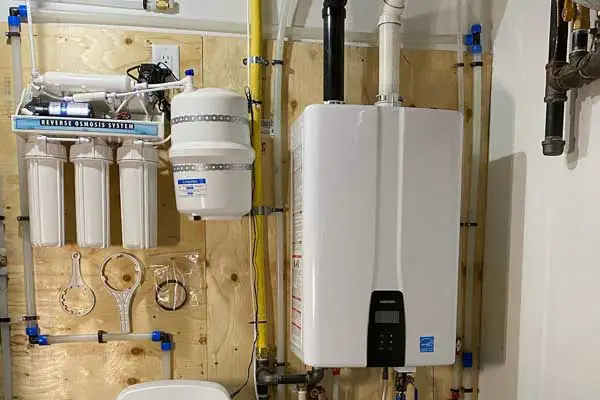The number one reason behind Navien tankless water heater leaking from bottom is bad installation. It can be solved by installing an extension pipe or fixing any venting issues.
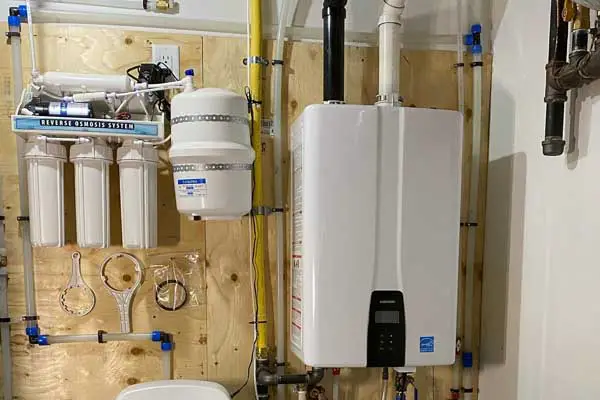
Apart from that, the main reasons behind it are:
- Hard or Acidic Water.
- Cracked Heat Exchanger.
- Leaky Mixing Valve.
- Inlet & Outlet Pipe Issues.
- Damaged Pressure Relief Valve.
- Excessive Water Pressure.
- Stuck Drain Valve.
- Faulty Air Separator.
Keep on reading to learn about all these issues in detail and find out how you can fix each of them. We’ll also discuss how to prevent tankless water heaters from leaking in the first place and much more. So, let’s dive in!
Table of Contents
- Navien Tankless Water Heater Leaking From Bottom [Reasons + Solutions]
- 1. Bad Installation
- 2. Hard Or Acidic Water
- 3. Cracked Heat Exchanger
- 4. Leaky Mixing Valve
- 5. Inlet & Outlet Pipe Issues
- 6. Damaged Pressure Relief Valve
- 7. Excessive Water Pressure
- 8. Stuck Drain Valve
- 9. Faulty Air Separator
- How To Prevent Heat Exchanger From Cracking
- FAQs:
- What should you do immediately when you notice the water heater leaking?
- How often should you change the pressure relief valve?
- Why does a drain valve fail?
- Why does a pressure relief valve go bad?
- Conclusion
Navien Tankless Water Heater Leaking From Bottom [Reasons + Solutions]
If you’ve been wondering why is my Navien water heater leaking, you’ll find the answer in this section as we’ll discuss the most common reasons behind it.
Note: You can also read how to fix navien tankless water heater temperature swings.
1. Bad Installation
Seeing your Navien tankless water heater leaking from the condensate drain indicates issues with the installation or the heat exchanger. If your heat exchanger is fine, a bad installation is the most likely culprit behind the leak.
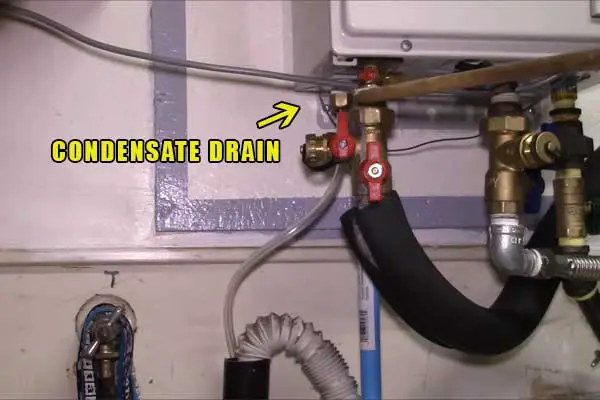
The main job of the condensation drain includes taking the heat out of the exhaust. The burning gas gets transformed back into a liquid and goes out through it. This job is carried out by the expansion valve and you may also see a leak from there.
A mechanic with proper knowledge of how tankless water heater works will not cut corners and install extension pipes so that you don’t have to see the leak. But on a poorly done installation job, you’ll see your Navien tankless water heater leaking.
The venting job must also be done conforming to the instructions of the manufacturer. If the plumber throws that to the wind and does the venting however he wants, condensation can cause leaks in the water heater.
Solution:
You can place a drain pan under the heater if you see water coming out of the condensate drain. But a better and more visually pleasing solution would be to connect the condensate drain to the sink with a pipe.
You’ll no longer have to see water dripping that way. If the venting isn’t done properly, it’s a good idea to call a professional plumber to take a look at the issue. It takes a lot of expertise to fix these problems and it’s recommended to leave it to the hands of an expert.
2. Hard Or Acidic Water
As an owner of a water heater, you need to know about the water conditions in your house. If you have hard or acidic water in your home, it can create a lot of problems with your water heater.
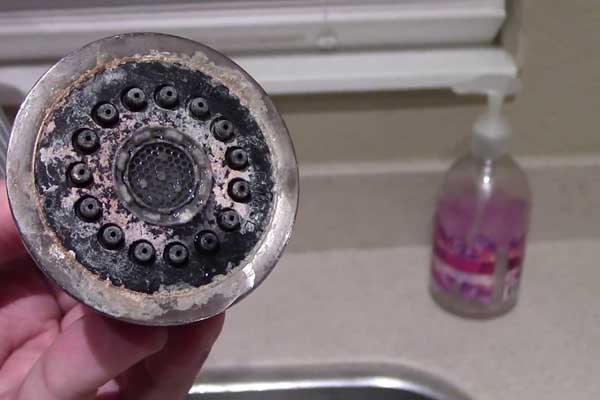
The minerals present in hard water will build up in the piping system over time. Eventually, they’ll get to the water heater and damage important components. It can create pinholes that’ll cause leaks.
Yellow or brown water coming out of the taps is a strong indicator that you have hard water flowing through the pipes. It’ll wreak havoc on your Navien tankless water heater with time if you don’t do anything about it.
Just like hard water, acidic water is also bad for your water heater. Any water that has a pH less than 6.5 is acidic. This type of water is extremely corrosive and can also lead to leaks.
How to know if you have acidic water? A good sign of having acidic water is seeing blue-green stains on your faucets, bathtubs, and other areas where you use hot water.
Solution:
If you have identified that you have hard water, you need to flush the system and remove the sediment that has built up over time. The preventive measure for this problem is to use a water softener.
As for the pipes that are cracked and leaking, they’ll have to be replaced. If you have acidic water, install an acid neutralizer to raise the pH level of water in your house. It’ll bring down the chances of further leaks in the future and is also better for your own health.
3. Cracked Heat Exchanger
If you find your Navien tankless leaking from the condensate drain, there’s a good chance that your heat exchanger is cracked and causing it. Heat exchangers tend to go bad with time. So, the chances of you having a bad one go even higher if your heater is old.
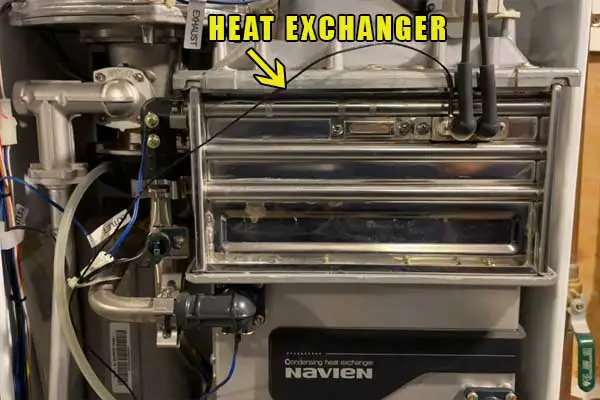
At times, the heat exchanger can leak at the top of the gasket. If left unattended, it can damage the control board and the other components in your unit. So, you need to inspect it immediately to know if it’s causing the issue.
Solution:
Replacing a lot of Navien parts is easy and cheap. Unfortunately, that’s not the case with heat exchangers. Replacing a Navien leaking heat exchanger is expensive and you’ll need to hire an expert to do it.
Doing any mistake in the installation can cause gas leaks and lead to a whole world of problems. So, don’t do it yourself. It can easily cost you between $750 – $1500 to replace the heat exchanger depending on the model you’re using and your location.
4. Leaky Mixing Valve
As the name suggests, the mixing valve combines both hot and cold water to give you the water of your desired temperature. Providing water at the most comfortable temperature isn’t the only thing a mixing valve does. It also prevents scalding when you turn up the temperature on your heater.
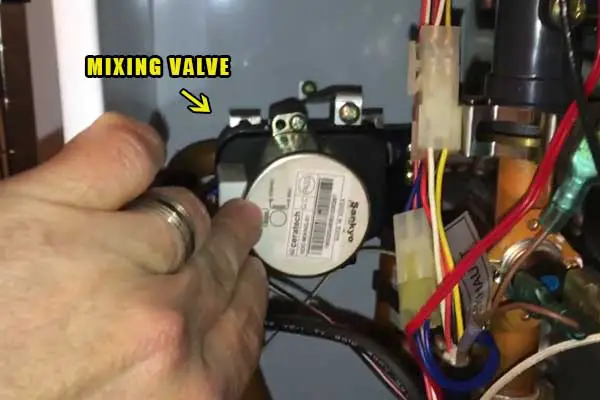
The mixing valve makes sure that there are no temperature fluctuations and that you get water at ideal temperatures. But with time, they can go bad and develop leaks. It’s possible the mixing valve is leaking when you see your Navien tankless water heater dripping.
Solution:
If your Navien mixing valve has gone bad and is starting to leak, you’ll have to replace it with a new one. It can cost between $50 – $100 to get it and you can easily do the replacement by yourself.
5. Inlet & Outlet Pipe Issues
The inlet pipe supplies cold water to the heater and the outlet pipe transfers the hot water from it. These pipes can loosen over time and cause leaks from the heater.
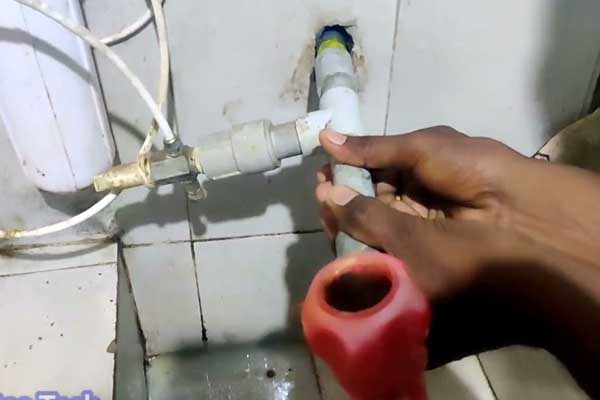
They can also get blocked if a rodent or some other animal gets caught up in it. A bird can also build its nest in the exhaust pipe and end up clogging it.
Solution:
The first and simplest solution to stop the water leaks is to tighten the pipes if they’re loose. If the pipes are blocked, then tightening them won’t work. You’d have to replace them in that situation.
6. Damaged Pressure Relief Valve
When too much water pressure builds up, it can cause a lot of issues and burst certain components. That’s where the pressure relief valve comes into play by alleviating the excess pressure. Your water heater will start to leak if this valve goes bad.
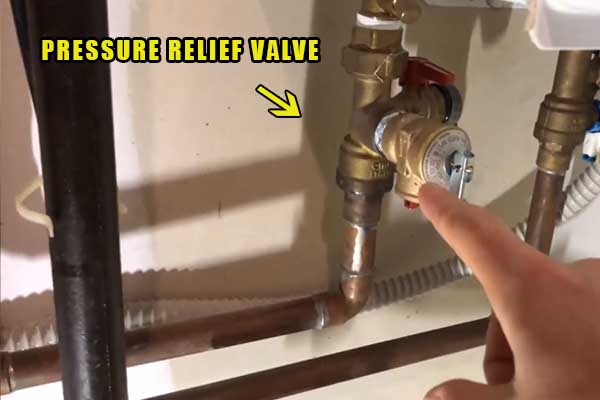
Solution:
Even setting the water temperature too high can cause too much pressure in your water heater. Make sure that you’ve not set a temperature that’s higher than 120 degrees Fahrenheit.
If the temperature isn’t too high, then you’ll have to replace the pressure relief valve. You can hire a plumber to do this job for you. But if you feel comfortable taking it on yourself, here are the steps to replace it:
- Turn off the power supply to your heater and unplug it.
- Make sure the gas supply is off and switch off all water supplies.
- Put a drain pan before removing the PRV to avoid having a puddle of water.
- Unscrew the old pressure relief valve and put the new one in its place.
That’s how easy it is. Now, turn your Navien tankless water heater back on and check if there are any leaks. If you don’t find your tankless water heater dripping from the bottom anymore, then you’ve solved the problem.
Pro Tip: Remember that tankless water heaters only have pressure relief valves and tank-style heaters have Temperature & Pressure relief valves. So, steer clear of getting a TPRV as that’s not what you need.
7. Excessive Water Pressure
It’s highly important that the flow rate of the water in your piping system matches the requirements of the heater so that it can do its job properly. Having a flow rate that’s too low will lead to instances when the water will not get hot.

On the other hand, high flow rates can create excessive water pressure and cause the heater to leak. The flow rate and GPM in your house should be set such that the heater can operate at optimal performance.
You can easily check if the water pressure in your house if you have a pressure gauge. Just connect it to one of the pipes and get a reading. In a residential area, the water pressure shouldn’t exceed 30 PSI.
Here’s an example of a pressure gauge reading that’s too high.
Solution:
How to fix a leaking tankless water heater? You already know what the ideal water pressure is for a house. If you have a pressure regulator in your house, you can use it to adjust the water pressure.
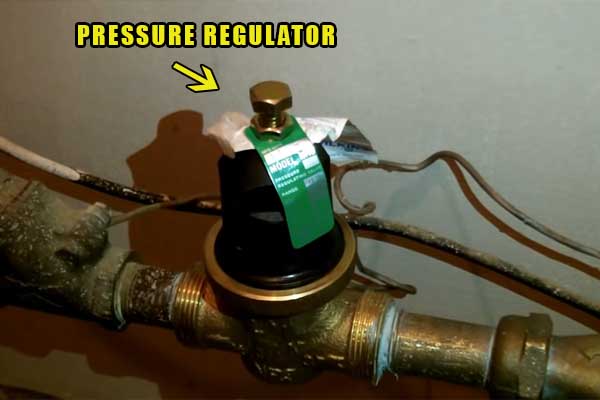
Turning the screw to the left will decrease the water pressure and turning it to the right will do the opposite. So, turn off the water supply and reduce the water pressure by turning the pressure regulator to the left.
Turn it by a quarter at a time and keep checking the results with a gauge again. Once you’re happy with the water pressure, you can stop adjusting.
As for the flow rate, it shouldn’t exceed 19 GPM. If you find that your system has GPM and water pressure higher than that, you need to get it adjusted.
8. Stuck Drain Valve
One of the reasons that could lead to your Navien tankless water heater leaking is a stuck drain valve. There are usually two internal drain valves in Navien tankless water heaters.
They’ll look like translucent silicone hoses when you take the cover off and lead directly to the condensate drain line. Inspect them and see if the leak is coming from any of them.
Solution:
Even if only one drain valve is leaking, it’s a good idea to replace both. Drain valves are fairly inexpensive. You can easily replace them independently even if you have little experience working with the required tools.
9. Faulty Air Separator
When you’re trying to locate the source of the leak, you should look into the air separator. Follow these steps to diagnose whether you have a Navien pump air separator leaking:
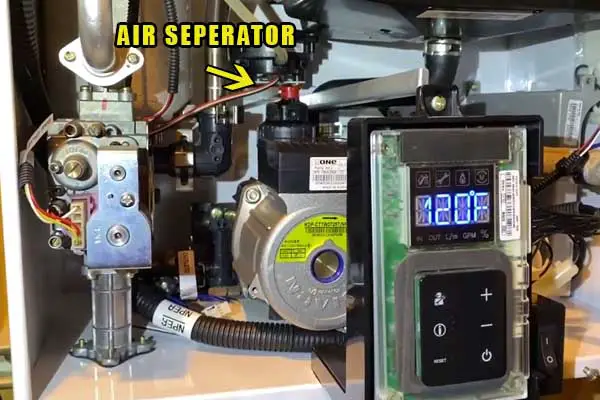
- Turn off the heater and shut off both the hot and cold water supply to it.
- Switch some taps on to eliminate any pressure that has built up.
- Remove the four screws and take off the front cover to gain access to it.
- Check if the air separator is leaking.
Solution:
If you’ve identified that the leak is coming from the air separator, you need to replace it. You can easily take it off by using water pump pliers.
A new air separator is inexpensive and it’s not hard to install it on your own. If the leak stops now, you’ve solved the main issue that was causing it.
How To Prevent Heat Exchanger From Cracking
Though heat exchangers don’t last forever, there are a few things you can do to make sure that you can maximize how long they last. Here are some tips you can follow to make sure it stays in good shape:
i). Don’t Let Your Heater Get Overheated
On your end, you need to make sure that you’re cleaning the heater at regular intervals. Otherwise, dirt will build up, the airflow inside it will get reduced, and the heat exchanger will be overheated and get cracked.
ii). Don’t Switch Between Heating & Cooling Immediately
If you frequently jump from heating to cooling, the metallic wall of the heat exchanger will contract and expand simultaneously. That’ll reduce its longevity and cause it to crack.
iii). Prevent Corrosion
Once again, this has to do with making sure that the heater is clean. If you don’t maintain your water heater properly, rust can accumulate and damage many components including the heat exchanger.
iv). How To Keep Navien Tankless Water Heater From Leaking
It may seem impossible at first that even tankless water heaters can leak but now as you know, it can happen. Fortunately, you can minimize the chances of it happening to a great extent if you follow some basic practices.
Here are our top tips to make sure that your tankless water heaters don’t start leaking anytime soon:
v). Do The Installation Properly
When you ignore installing the tankless water heater as per the instructions of the manufacturer, making mistakes becomes inevitable. Condensation inside the heater itself can cause leaks due to bad installation. So, follow the instructions to the tee to avoid this issue.
vi). Use Water Softener
This tip is applicable if you have hard water in your home. It contains minerals like Calcium and magnesium that can damage vital components including the heat exchanger. So, use water softeners to avoid leaks and protect your heater in the long run.
vii). Do Annual Maintenance Of The Heater
If you were wondering how often should you flush a Navien tankless water heater, the answer is at least once a year. With time, the water heater can get corroded and undergo lime build-up. Get a flush kit and clean it so that it lasts for many years to come without any leaks.
viii). How To Stop Tankless Water Heaters From Damaging Your Property
There is a simple solution to make sure that there’s little to no damage to your property when your tankless water heater starts leaking. Just install a drain pan. The water will go there instead of affecting your property.
It’s unlikely for tankless water heaters to leak anyways. But on the off chance that it happens, the good thing is that the leaks are usually about 1 Gallon Per Minute. So, even if there’s a leak, it’s not likely that it’ll do any major damage.
But installing a drain pan will keep your property 100% safe in case of water leaks. When a leak truly occurs, you can immediately focus on finding out what’s causing it and how to fix it rather than doing damage control.
FAQs:
What should you do immediately when you notice the water heater leaking?
The first thing you should do is try and identify the leak in a short time. Then, turn off the water and gas supply to it. If you’ve found the issue, then fix it. Otherwise, call in an expert for a proper diagnosis.
How often should you change the pressure relief valve?
We recommend that you check it at least once every year. Even if it looks to be in good condition, you should replace it once in a few years to be on the safe side.
Why does a drain valve fail?
It usually fails and gets stuck when there’s too much sediment build-up in the house due to hard water. Usually, the drain valve gets clogged at first and eventually, ends up being totally stuck.
Why does a pressure relief valve go bad?
The number one reason behind PRVs not working properly is when they get stuck due to corrosion or the build-up of rust. They can also get frozen in extremely cold climates.
Conclusion
Most people think that tankless water heaters don’t leak. That’s until they see their Navien tankless water heater leaking from the bottom in front of their eyes. Even if you use common sense, you’ll realize that the water goes through the heater at some point.
That makes it prone to leakage. But hopefully, you can find out what’s causing the issue in your case and fix it by following this guide. Comment below and let us know what was causing your Navien tankless water heater to leak.
